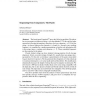Free Online Productivity Tools
i2Speak
i2Symbol
i2OCR
iTex2Img
iWeb2Print
iWeb2Shot
i2Type
iPdf2Split
iPdf2Merge
i2Bopomofo
i2Arabic
i2Style
i2Image
i2PDF
iLatex2Rtf
Sci2ools
MST
2006
2006
Sequencing from Compomers: The Puzzle
The board game FragmindTM poses the following problem: The player has to reconstruct an (unknown) string s over the alphabet . To this end, the game reports the following information to the player, for every character x : First, the string s is cleaved wherever the character x is found in s. Second, every resulting fragment y is scrambled by a random permutation so that the only information left is how many times y contains each character . These scrambled fragments are then reported to the player. Clearly, distinct strings can show identical cleavage patterns for all cleavage characters. In fact, even short strings of length 30+ usually have non-unique cleavage patterns. To this end, we introduce a generalization of the game setup called Sequencing from Compomers. We also generate those fragments of s that contain up to k uncleaved characters x, for some small and fixed threshold k. This modification dramatically increases the length of strings that can be uniquely reconstructed. W...
| Added | 14 Dec 2010 |
| Updated | 14 Dec 2010 |
| Type | Journal |
| Year | 2006 |
| Where | MST |
| Authors | Sebastian Böcker |
Comments (0)

